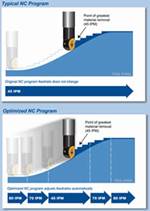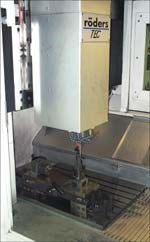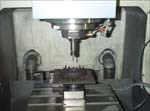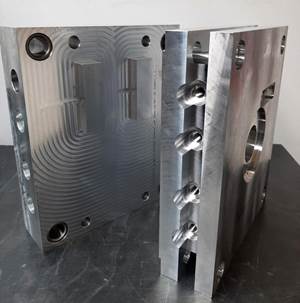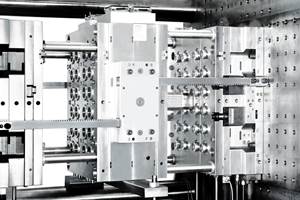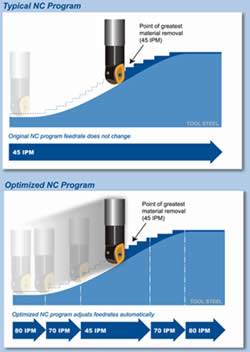Using CAD Data to Build Molds By the Numbers Can Reduce Costs and Leadtime
Crucial initial decisions must be made before machining begins.
Moldmaking is both an art and science and has always been at the forefront of innovation in metalworking technology. It's a dynamic arena where new ideas are continually being advanced. However, staying competitive in moldmaking can be a challenge, particularly for small shops. With the cost of new equipment and price pressure from Asia, keeping a shop strong while reducing costs and leadtimes is very difficult.
One way to reduce the cost of manufacturing and reduce leadtime is by setting up a manufacturing system that uses equipment and personnel to their fullest potential. The foundation for this type of manufacturing system is the use of CAD data to help in making key process decisions that ultimately improve machining precision and reduce non-productive time. This moldmaking by the numbers approach can have a significant impact keeping small shops competitive.
The first step is in the design of the mold. CAD systems offer an efficient means of design, plus offer the opportunity to establish tooling points for milling operations and can be used to create inspection programs when used in conjunction with coordinate measuring machines and other inspection equipment. CAD data also can play a critical role in selecting process sequence and in setting up wire and sinker EDM operations and electrode machining operations.
Process Selection and Process Sequence
A key decision early in the process is determining what machining operations will be used and in what order. Most mold shops have a combination of CNC milling, EDM wire and EDM sinker equipment. Each of these processes has advantages and disadvantages when producing a close tolerance mold. The proper selection of process and sequence of process will not only result in more precise dimensional control, but also will reduce manufacturing time by reducing bench work.
Machining considerations should be analyzed during the development of the CAD model. If this isn't done, the programmer may not be able to use certain machining strategies. The worst case here is that the model may have to be modified, significantly adding to leadtime. Not all workpieces are suitable for hard milling, for example. The smallest internal radius, the largest working depth and the hardness of the material all have to be considered when making this decision.
Model analysis is an area where the small shop has an advantage over larger, offshore competitors. Poorly developed models are common, and a small shop can add value to its services by working closely with customers to assure the CAD design is optimized before release to production.
Post Mold Design Decisions
At Journeyman Tool (South Bend, IN), the decision on process selection and process sequence is made after the mold design has been finalized. The shop uses CNC milling techniques and has extensive EDM capability including a wire EDM and two sinker EDMs.
In a typical pre-production meeting, the designer, lead and machine operators use the solid model of the part—created from the CAD program—to help decide which production process to use.
"We look at the hardness of the material we have to cut and the radii. Based on material hardness and mold configuration, we might decide to rough using hard milling techniques before heat treating and then finish with EDM, or we may decide to use wire and sinker EDM for the entire process," says Mike Meyer. "If we need to machine a deep cavity, we might not be able to reach it with a small cutter, so we would choose EDM. If we have a through pocket, wire EDM would be the choice."
Another area where reference to the CAD-generated solid model helps determine the process is in the amount of material to be removed. Potential breakage of part features and size adjustments are other factors. "A thin or delicate area could break during the production process. That part feature has to be accounted for when selecting the process," Meyer says. "A dimensionally accurate solid model of the part can help determine all of these things."
Journeyman Tool uses EDM for the majority of its mold production. The shop has reduced its electrode production time by going to an in-house developed custom tool holding system for sinkers. "We've adapted a toolholding system to mount the electrodes on them, rather than purchase the holders and mount them to the electrodes," Meyer explains. "This reduces our costs and we don't need a new holding system for each job, plus, our moldmakers can still make electrodes the traditional way, on a square or rectangular shank. After we're done burning a job, we can take them off the holders and put them on later and they still repeat."
Meyer says that his experience shows that his shop can machine three or four electrodes and EDM faster than they can hard mill a workpiece. "In some cases, because of chip build-up, we don't feel comfortable running a continuous unattended milling operation, but we are comfortable running EDM lights out," Meyer says.
Selecting Process Order by Speed
At M&M Tool and Mold, Inc. (Green Bay, WI), speed is the defining criterion in selecting the process order, according to co-owner Mike Richard. "A typical mold build starts with prepping steel for heat treatment, wire EDM, then sinker EDM. To accelerate the mold build, these processes are done concurrently with design, programming and electrode manufacturing."
M&M Tool and Mold operates three sinker EDMs and two wire EDMs. "Sinker EDM represents at least 50 to 60 percent of our finishing operations," Richard explains.
Electrode material selection is a critical factor in using EDM techniques to produce a workpiece to finish tolerances. Graphite is the material of choice for the majority of EDM sinker applications.
The quality of the graphite can affect electrode fabrication time, the number of electrodes needed to complete a job, EDM time, accuracy of the cavity and polishing time. Factors such as flexural strength, particle size and microstructure influence the level of detail and surface finish that can be expected in the sinker EDM operation.
"The choice of material is job-specific and depends on the level of detail needed," says Richard. "We generate our own mold designs. CAD data is helpful here because you can quickly determine where the precision needs to be."
CAD data can be used to program elec-trode machining operations. Dimensional data can be downloaded to software that automates electrode design and generates simulations of electrode action so that users can test cut prior to burning. The software also allows users to try different qualities of graphite to determine the opti-mum grade before actual burning begins.
At M&M Tool and Mold, design data can be used to program the shop's two graphite milling machines to produce precision machined electrodes—virtually eliminating the need for benching. One machine is interfaced with a 114-position automatic electrode changer.
Advances in high-speed machining techniques have made it possible to machine precision details into virtually any grade of graphite. While this can be viewed as a potential cost saving development, it is still critical that the proper graphite grade be selected to meet the final mold design criteria, particularly for thin ribs and when electrode wear and metal removal rates are a consideration.
M&M Tool and Mold also uses CAD data to set up wire EDM operations. The shop downloads dimensional data from the CAD model to a special software program that helps select wire size, power setting and other process parameters. This program is then downloaded through the shop's intranet to the wire EDMs.
The Key to Competing
The key to staying competitive in moldmaking operations is to achieve the most productivity from the equipment at hand. CAD data can be instrumental in assuring that hard milling and EDM operations are carried out in the most efficient manner possible, keeping non-productive time to a minimum.
Related Content
Mold Materials, 3D Printing Technologies for Next-Gen Moldmaking
As moldmaking advances, so too do the materials and processes involved in their efficient production, including these latest mold materials and 3D printing technologies.
Read MoreHow is an Aluminum Mold Energy-Efficient?
Nine ways aluminum molds save energy and production costs.
Read MoreHow to Lower Cycle Times With the Right Tool Steel
Combining excellent mechanical properties, high wear resistance and high thermal conductivity in a specialty tool steel yields cycle time reduction.
Read MoreMoldMaking Technology's Hottest Tips of 2023
The staff at MoldMaking Technology prides ourselves on bringing you the most helpful, relevant tips in the industry. Here are the top five most-viewed tips of 2023 based on Google Analytics.
Read MoreRead Next
Simulate and Optimize Your Mold Build Process
Mold shops can increase efficiency, lengthen tool and machine life and achieve better surface finish with the same software they use to verify their increasingly complex NC programs.
Read MoreAre You a Moldmaker Considering 3D Printing? Consider the 3D Printing Workshop at NPE2024
Presentations will cover 3D printing for mold tooling, material innovation, product development, bridge production and full-scale, high-volume additive manufacturing.
Read MoreHow to Use Strategic Planning Tools, Data to Manage the Human Side of Business
Q&A with Marion Wells, MMT EAB member and founder of Human Asset Management.
Read More
